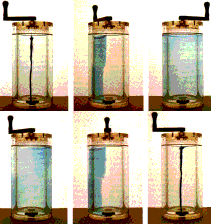home
contents Mathematics
the difference between fractal and space dimensions
Ian Stewart drips his tap
home |
contents Mathematics |
previous
: the difference between fractal and space dimensions |
next
: Ian Stewart drips his tap |
| direct to all other pages of the section ----> | 00 | 01 | 02 | 03 | 10 | 11 | 12 | 20 | 21 | 30 | 31 | 32 | 33 | 34 |
Birth of
a new dimension
in a natural
phenomenon
and
simultaneous
surge of chaos
Continuity
of deformations in space
A continuous path is a path which
does not make sudden jumps. So to speak, every position 'touches' the following
one. The body does not disappear from a place to reappear in a far away
place at the closest following instant.
By analogy with a continuous path,
a continuous deformation doesn't make a sudden break between two contiguous
states. It may break sometime, but then, it's really broken and the deformation
has come to an end.
| When 2 bodies are not linked
continuously in space, we state they are separated. We state that they
do not constitute any more one body which deforms itself in space, but
constitute two distinct bodies.
That's the precise point we shall consider is wrong. Comment: here we shall limit ourselves to evoke discontinuous phenomena 'on the usual scale of visibility'. But the reasoning will be worth all the way for the area of elementary particles, where the same type of questioning is more and more frequent, in terms of: 'how can 2 particles, which are too distant to have enough time to exchange data at the speed of light, react in a coordinate way so that what happens to one, interacts instantly to the other?' |
We begin with a visibly continuous
deformation.
We take a receptacle in which we
have water rotating. Then in the swirl, we drop an ink drop. We can perfectly
see how the drop deforms itself. That is, dilutes itself, and begins moving
driven by the water. The continuity of this deformation, implies for example
that colored water will not appear all of a sudden in any volume of clear
water. Colored water appears only in places where the movement can drive
some ink, or in places where the dilution by diffusion has brought some.
Now we make another experiment.
[in 'l'ordre du chaos' - 'la mémoire des atomes', by Richard
Brewer and Erwin Hahn - Bibliothèque Pour la Science - diffusion
Belin. The photographs of this experiment are
from this article, and in order from left to right on the first line then
on the second line]
 Inside
a fixed cylinder we place a rotating one, and the space between the two
cylinders is filled with a transparent and viscous fluid. We let a vertical
dribble of coloring leak. Then we rotate the inner cylinder till the coloring
is mixed with fluid.
Inside
a fixed cylinder we place a rotating one, and the space between the two
cylinders is filled with a transparent and viscous fluid. We let a vertical
dribble of coloring leak. Then we rotate the inner cylinder till the coloring
is mixed with fluid.
At this point, all is 'normal',
in a continuous way. Exactly as in the first experiment, except that viscosity
doesn't add an effect of diffusion to the effect of mixing by movement.
When the coloring is mixed, we start rotating the cylinder in the opposite direction. Little by little the coloring 'demixes', and after an equal number of tours the vertical dribble of coloring is perfectly restored. That's a bit amazing. Even more so for someone who can only see the 2nd part of that experiment: in front of him he has a liquid in which a coloring is being mixed, he rotates it, and instead of mixing a little more as it usually does, it 'demixes'.
Astonishing as it may be, it remains
continuous. The coloring does not reappear demixed suddenly, at random
in the liquid. It 'reconcentrates' in a continuous way.
| Usually it is said that this experiment
reveals 'the hidden order of chaos', and the authors of the article where
this experiment is related see in it an aspect of 'atoms memory'.
Here will the hypothesis be that,
in fact, there is no real 'chaos' when the coloring is dispersed, for precisely
we suppose that the coloring molecules never really disperse.
They never completely lose their respective positions, and therefore they
do not find them again in the end, 'as if by magic'. Such a perfect restoration
of initial arrangement, after a complete dispersion, seems to us, unlikely.
It can only occur if the arrangement never really dismantles.
|
Molecules cannot have their initial
position 'in memory' for they have no memory organ,
and
so they cannot 'find again' their initial position at the end of the experiment.
They always remain in it by some aspect of the phenomenon.
What this
aspect of the phenomenon is, we can now tell: it's a dimension. The positions
of the molecules are continuous in a dimension of the phenomenon. For
us, the problem is that space dimensions do not show this dimension.
And
they do not show this dimension because they cannot do it, which is
what we shall try to explain now.
With this aim, we shall face in our
turn the eternal and irritating problem of the dripping tap.
home |
Math |
top |
next
: |
author |